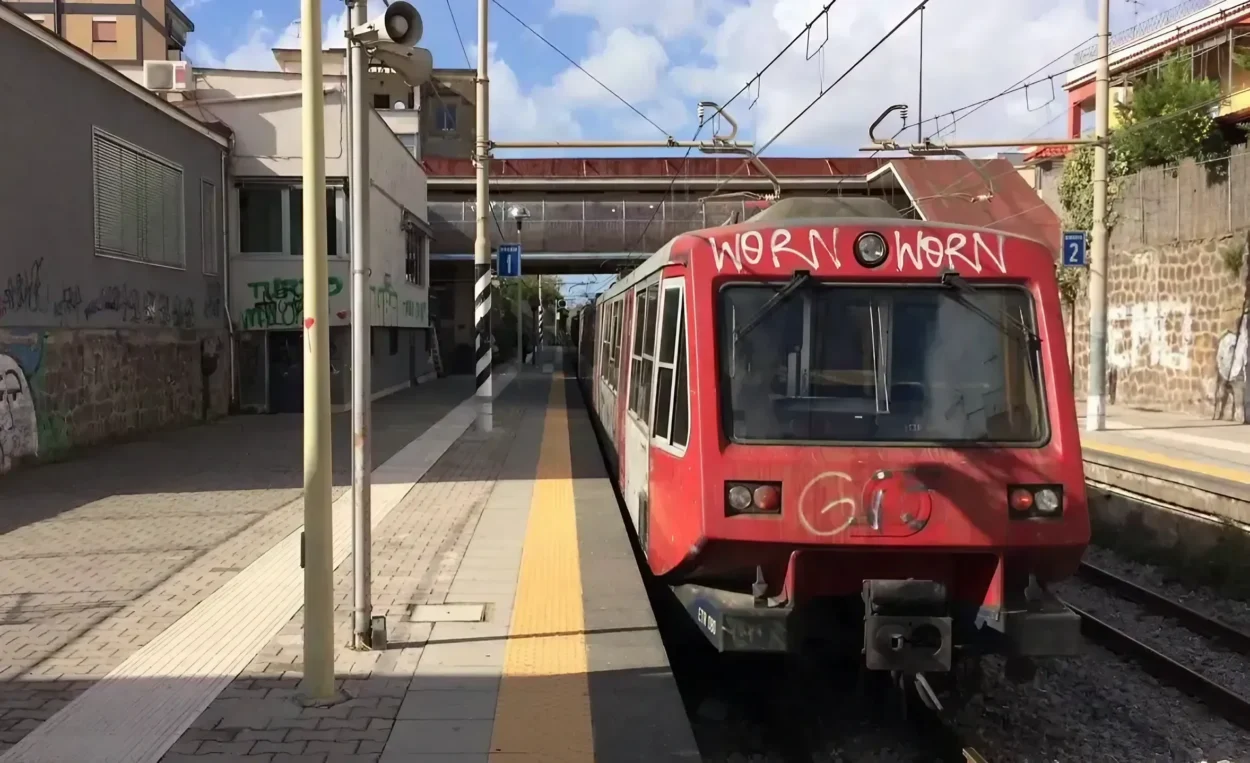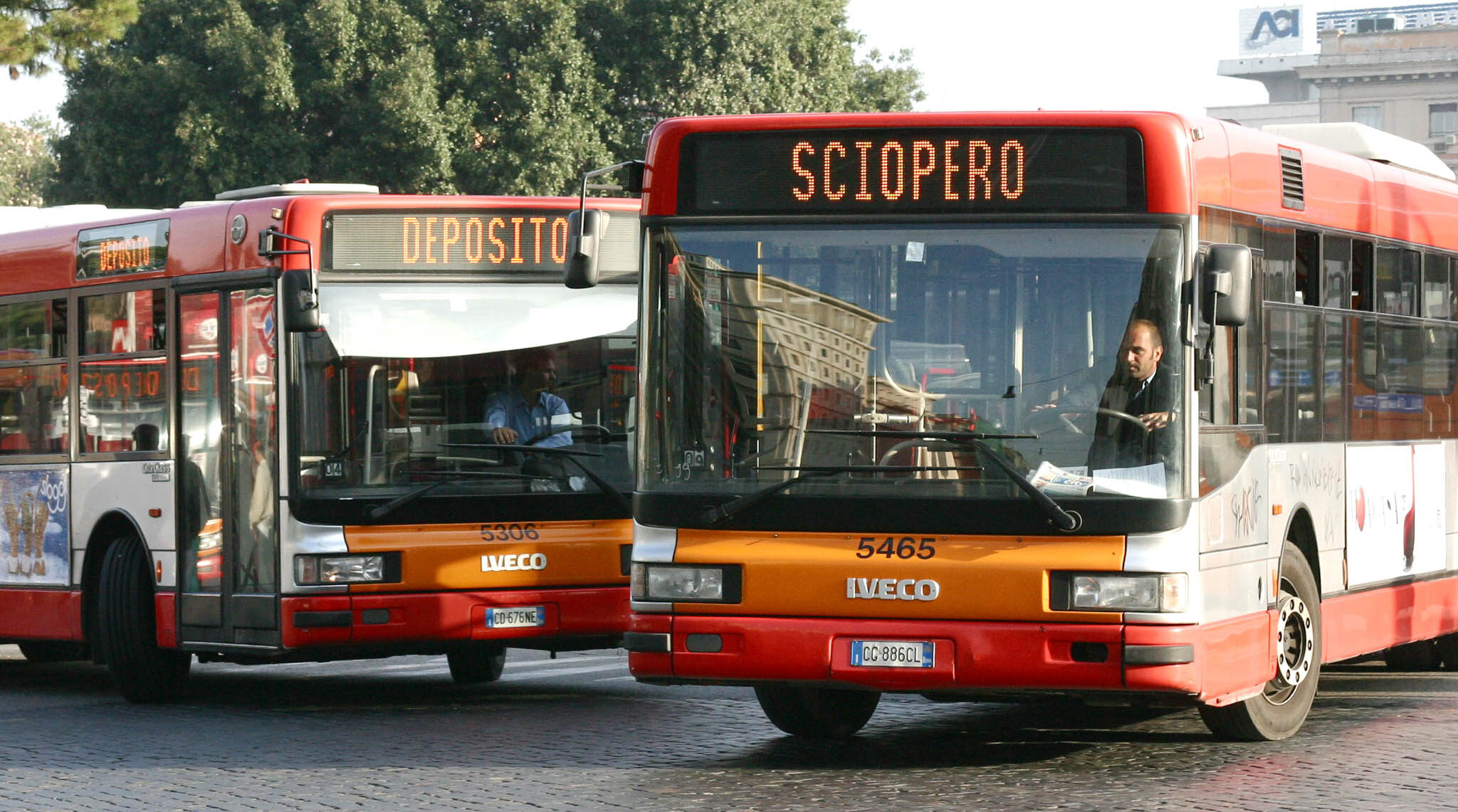Circumvesuviana

The things you need to know
- The Circumvesuviana timetables are not always the same. In summer, summer time applies, while in winter, winter time applies
- Trains for multiple destinations pass on the Circumvesuviana tracks, check the destination of the train before getting on board
- Some lines, such as the Napoli – Poggiomarino and the Napoli – Torre del Greco, are suspended usually from the end of June to the beginning of September with replacement services by bus on some parts of the routes
- There are night support buses to replace the railway lines but they often suffer cancellations
- Unfortunately, the Circumvesuviana trains are not always on time and suffer from a lot of cancellations
- The ticket must be purchased before entering the station when passing the turnstiles
- The ticket must be stamped or activated at the turnstiles, but they are not present in all stations
- Tickets cannot be purchased on board
- The service is managed by EAV so ANM tickets cannot be used
- You can enter with the contactless ticket via TapIn and TapOut (Bancomat, Mastercard, Visa)
- You can buy a digital ticket via the GoEav App
- Trains are often very crowded
- You can check the cancellation of individual trains on the Telegram EavOfficial channel
- Beware of pickpockets, especially on the line to Sorrento
FAQ – frequently asked questions
- Track to Sorrento: Generally from platform 3 of Piazza Garibaldi, but check the destination of the arriving train on the table on the front of the first carriage. Trains for multiple destinations pass on the Circumvesuviana tracks!
- Circumvesuviana location in Naples Garibaldi: Located in the basement (-1) of Piazza Garibaldi, also accessible from Porta Nolana.
- Purchase Tickets Online/App: Available.
- Campania Express: Train dedicated to visitors to Sorrento, Faito, Pompeii and Herculaneum.
- Ticket cost for Sorrento: Specific for each route.
- Disabled Accessibility: Varies from station to station, most not accessible.
How Contactless tickets work and why you need to pay attention to TapIn and TapOut
Unlike many other European metropolises, in Naples the differentiation of routes and companies has complicated the creation of contactless payment via credit and debit cards, as the cost of the trip varies according to the distance traveled (divided into bands).
To overcome this problem, TAPin and TAPout have been introduced, i.e. the payment card must be swiped at the reader both at the entrance both at the exit, often the exit one is usually present near the turnstiles before leaving.
The system will thus automatically calculate the appropriate figure based on the exit band, while in case of missed TAPout will charge the highest amount for the entire route.
Circumvesuviana timetables (from Naples Porta Nolana)
- First Run:
- Sorrento: 05:54
- Sarno: 06:28
- Baiano: 05:56
- Last run:
- Sorrento: 21:30
- Sarno: 20:04
- Baiano: 20:02
Circumvesuviana timetables (for Naples Porta Nolana)
- First Run:
- Sorrento: 06:00
- Sarno: 06:08
- Baiano: 06:08
- Last run:
- Sorrento: 21:36
- Sarno: 20:10
- Baiano: 20:08
The stops of the Circumvesuviana lines
Naples – Sorrento line
| Stop |
|---|
| Napoli |
| Porta Nolana |
| Piazza Garibaldi |
| Via Gianturco |
| San Giovanni a Teduccio |
| Barra |
| S. Maria del Pozzo |
| S. Giorgio |
| S. Giorgio Cav. Bronze |
| Portici Bellavista |
| Portici Via Libertà |
| Ercolano Scavi |
| Herculaneum |
| Best Gold |
| Greek's tower |
| Via Sant'Antonio |
| Villa del Monte |
| Via dei Monaci |
| Villa of the Brooms |
| Leopardi |
| Via Viuli |
| trecase |
| Torre Annunziata |
| Oplontis a. |
| Oplontis p. |
| Pompeii Excavations |
| Villa of the Mysteries |
| Moregine |
| Persian Bridge |
| Pioppaino |
| Via Nocera |
| Castellammare |
| Pozzano |
| Scrajo |
| Vico Equense |
| Sejanus |
| Meta |
| Piano |
| Sant'Agnello |
| Sorrento |
Naples – Baiano line
| Stop |
|---|
| Napoli |
| Porta Nolana |
| Piazza Garibaldi |
| Centro Direzionale |
| Poggioreale |
| Botteghelle |
| Casoria Arpino |
| Volla |
| Willow |
| casalnuovo |
| La Pigna |
| Talona |
| Piedmont Park |
| Pratola Ponte |
| Pomigliano D'Arco |
| Alfa Lancia Varco 2 |
| Alfa Lancia Varco 4 |
| Acerra |
| Castelcisterna |
| brusciano |
| De Ruggiero |
| Via Vittorio Veneto |
| Marigliano |
| San Vitaliano |
| Scisciano |
| Saviano |
| Nola |
| Cimitile |
| Camposano |
| Cicciano |
| Roccainola / Tufino |
| Partenio Park |
| Avella / Sperone |
| Baiano |
Naples – Sarno line
| Stop |
|---|
| Napoli |
| Porta Nolana |
| Piazza Garibaldi |
| Via Gianturco |
| San Giovanni a Teduccio |
| Barra |
| Ponticelli |
| Vesuvius De Meis |
| cercola |
| Pollena Trocchia |
| Guindazzi |
| Madonna of the Arch |
| Sant'Anastasia |
| Villa Augustea |
| Somma Vesuviana |
| Trieste district |
| Ottaviano |
| San Leonardo |
| San Giuseppe |
| Casilli |
| Terzigno |
| Ribbon |
| poggiomarino |
| Striano |
| San Valentino Torio |
| Sarno |
Naples – Poggiomarino line
| Stop |
|---|
| Napoli |
| Porta Nolana |
| Piazza Garibaldi |
| Via Gianturco |
| San Giovanni a Teduccio |
| Barra |
| S. Maria del Pozzo |
| S. Giorgio |
| S. Giorgio Cav. Bronze |
| Portici Bellavista |
| Portici Via Libertà |
| Ercolano Scavi |
| Herculaneum |
| Best Gold |
| Greek's tower |
| Via Sant'Antonio |
| Villa del Monte |
| Via dei Monaci |
| Villa of the Brooms |
| Leopardi |
| Via Viuli |
| trecase |
| Torre Annunziata |
| Oplonti |
| Boscotrecase |
| Boscoreale |
| Pompeii Sanctuary |
| Scafati |
| Saint Peter |
| Via Cangiani |
| poggiomarino |
Torre Annunziata – Poggiomarino line
| Stop |
|---|
| Torre Annunziata |
| Oplonti |
| Boscotrecase |
| Boscoreale |
| Pompeii Sanctuary |
| Scafati |
| Saint Peter |
| Via Cangiani |
| poggiomarino |
Naples – Torre del Greco line
| Stop |
|---|
| Napoli |
| Porta Nolana |
| Piazza Garibaldi |
| Via Gianturco |
| San Giovanni a Teduccio |
| Barra |
| S. Maria del Pozzo |
| S. Giorgio |
| S. Giorgio Cav. Bronze |
| Portici Bellavista |
| Portici Via Libertà |
| Ercolano Scavi |
| Herculaneum |
| Best Gold |
| Greek's tower |
The history of the Circumvesuviana of Naples
La Circumvesuviana Railway of Naples, is one of the main arteries of public transport in the Vesuvian area, inaugurated in 1884 with the single line Naples - Baiano, passing through Nola, by the company Chemin de fer Naples-Nola-Baiano et extensions.
It was only in the 1890, precisely the November 18, that the Circumvesuviana assumed a role much more similar to that currently held, with the new line Naples - Ottaviano, extended up to St. Joseph Vesuvius the next year.
In 1901 there was the change of hands under the management of the anonymous Company Southern Secondary Railway Roads which extended the areas served by the line to Sarno and inaugurated a new line that followed the coast line, serving municipalities such as Portici, Ercolano, Torre del Greco, Torre announces and Pompeii, and then re-link to the Sarno line at Poggiomarino, completing a ring of railway network around the Vesuvius, from which it derives the name Circumvesuviana.
It was electrified in the 1905 on the line Naples - Pompeii - Poggiomarino, in the first post-war period followed the rest of the railway line.
In 1934 the line was inaugurated Torre Annunziata - Pompeii Excavations - Castellammare di Stabia, already electrified.
After the reconstruction following the bombardments of the Second World War and the eruption of Vesuvius del 1944, resumed work on the extension to Sorrento, begun in the previous decade. With a gallery of almost 10km between Castellammare di Stabia and Vico Equense, the 6 January 1948 fully entered the Sorrento section.
From Years' 70 onwards the railway underwent various upgrades, up to 1985 when the works for the line began Pomigliano D'Arco - Scisciano, under the funds allocated by the Campania Region to which the network of the Circumvesuviana was entrusted in management commission. The new section was completed only in the 1997.
During the late 90 and early 2000 years, the network underwent further modernization with the introduction of new stops.
Only in 2001 commissarial management ceased to leave space for the company Circumvesuviana SRL owned by the Campania Region.
In the same period the branch was inaugurated Botteghelle - San Giorgio a Cremano (Line Naples - Baiano), while in the 2009 the Naples - Poggiomarino section between the Boscoreale and Boscotrecase stations was reopened.
In 2012 the company is incorporated byEAV (Autonomous Body Volturno).
Latest news and updates





